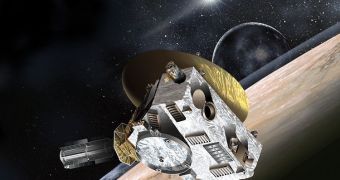The NASA New Horizons spacecraft – the fastest robotic explorer ever built – is celebrating its sixth anniversary flying through space. The probe is heading for Pluto, but won't get there until 2015. At this point, all systems are nominal, and everything is going according to plan.
Officials from the American space agency announced that the New Horizons probe celebrates its anniversary each year on January 19. It launched to the skies in early 2006, and experts project that it will reach Pluto and its moons on July 14, 2015.
The mission is managed by experts with the Applied Physics Laboratory (APL) at the Johns Hopkins University (JHU), and colleagues at the Southwest Research Institute (SwRI), in Boulder, Colorado.
The probe blasted off aboard an Atlas V 551 delivery system, from Space Launch complex 41 (SLC-41) at the Cape Canaveral Air Force Station (CCAFS). At this point, it is traveling at a speed of around 15.49 kilometers per second, the equivalent of 3.265 astronomical units per year.
An AU represents the mean distance between Earth and the Sun, or about 93 million miles (157 million kilometers). It currently takes about 3 hours for light to travel between Mission Control and the spacecraft, meaning that the response to any command sent out takes about 6 hours to return.
It will take a total of 9 years for New Horizons to complete its extremely-long flight, which is only surpassed in length and duration by those made by the NASA Voyager and Pioneer spacecraft.
“It's really around the corner. We're just more and more excited,” says SwRI New Horizons principal investigator Alan Stern, quoted by Space. He explains that the mission is divided into early-, mid- and late-cruises, which last about 3 years each.
Stern adds that the probe is now getting ready to make the transition from its mid- to its late-cruise, marking yet another important milestone. Throughout the remainder of the flight, scientists will continuously monitor the instruments aboard the probe, as well as its other systems.
The seven-instrument scientific suite aboard will image Pluto first and foremost, but also its four moons: Charon, Nix, Hydra and S/2011 P1. The latter was discovered on July 20, 2011, by SETI Institute investigators using the NASA/ESA Hubble Space Telescope.

 14 DAY TRIAL //
14 DAY TRIAL //